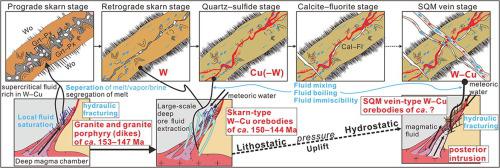Geoscience Frontiers ( IF 8.9 ) Pub Date : 2021-07-24 , DOI: 10.1016/j.gsf.2021.101278 Xiaolong He 1 , Da Zhang 1 , Yongjun Di 1 , Ganguo Wu 1 , Bojie Hu 1 , Hailong Huo 1 , Ning Li 1 , Fang Li 1

|
The Zhuxi deposit is a recently discovered W–Cu deposit located in the Jiangnan porphyry–skarn W belt in South China. The deposit has a resource of 3.44 million tonnes of WO3, making it the largest on Earth, however its origin and the evolution of its magmatic–hydrothermal system remain unclear, largely because alteration–mineralization types in this giant deposit have been less well-studied, apart from a study of the calcic skarn orebodies. The different types of mineralization can be classified into magnesian skarn, calcic skarn, and scheelite–quartz–muscovite (SQM) vein types. Field investigations and mineralogical analyses show that the magnesian skarn hosted by dolomitic limestone is characterized by garnet of the grossular–pyralspite (pyrope, almandine, and spessartine) series, diopside, serpentine, and Mg-rich chlorite. The calcic skarn hosted by limestone is characterized by garnet of the grossular–andradite series, hedenbergite, wollastonite, epidote, and Fe-rich chlorite. The SQM veins host high-grade W–Cu mineralization and have overprinted the magnesian and calcic skarn orebodies. Scheelite is intergrown with hydrous silicates in the retrograde skarn, or occurs with quartz, chalcopyrite, sulfide minerals, fluorite, and muscovite in the SQM veins.
Fluid inclusion investigations of the gangue and ore minerals revealed the evolution of the ore-forming fluids, which involved: (1) melt and coexisting high–moderate-salinity, high-temperature, high-pressure (>450 °C and >1.68 kbar), methane-bearing aqueous fluids that were trapped in prograde skarn minerals; (2) moderate–low-salinity, moderate-temperature, moderate-pressure (~210–300 °C and ~0.64 kbar), methane-rich aqueous fluids that formed the retrograde skarn-type W orebodies; (3) low-salinity, moderate–low-temperature, moderate-pressure (~150–240 °C and ~0.56 kbar), methane-rich aqueous fluids that formed the quartz–sulfide Cu(–W) orebodies in skarn; (4) moderate–low-salinity, moderate-temperature, low-pressure (~150–250 °C and ~0.34 kbar) alkanes-dominated aqueous fluids in the SQM vein stage, which led to the formation of high-grade W–Cu orebodies. The S–Pb isotopic compositions of the sulfides suggest that the ore-forming materials were mainly derived from magma generated by crustal anatexis, with minor addition of a mantle component. The H–O isotopic compositions of quartz and scheelite indicate that the ore-forming fluids originated mainly from magmatic water with later addition of meteoric water. The C–O isotopic compositions of calcite indicate that the ore-forming fluid was originally derived from granitic magma, and then mixed with reduced fluid exsolved from local carbonate strata. Depressurization and resultant fluid boiling were key to precipitation of W in the retrograde skarn stage. Mixing of residual fluid with meteoric water led to a decrease in fluid salinity and Cu(–W) mineralization in the quartz–sulfide stage in skarn. The high-grade W–Cu mineralization in the SQM veins formed by multiple mechanisms, including fracturing, and fluid immiscibility, boiling, and mixing.
中文翻译:

华南岩浆-热液系统演化与朱溪巨型钨铜矿床的形成
竹溪矿床是新近发现的W-Cu矿床,位于华南江南斑岩-矽卡岩W带。该矿床拥有 344 万吨 WO 3的资源量,使其成为地球上最大的,但它的起源和岩浆-热液系统的演化仍不清楚,主要是因为除了对钙质矽卡岩矿体的研究外,这个巨大矿床中的蚀变-矿化类型研究较少。不同类型的矿化可分为镁质矽卡岩、钙质矽卡岩和白钨矿-石英-白云母 (SQM) 脉类型。野外调查和矿物学分析表明,以白云质灰岩为主体的镁质矽卡岩的特征是粗长石榴石(火石、铁铝榴石和锰铝榴石)系列的石榴石、透辉石、蛇纹石和富镁绿泥石。以石灰岩为主体的钙质矽卡岩的特征是粗橄榄岩-红霞石系列石榴石、海登堡岩、硅灰石、绿帘石和富铁绿泥石。SQM 矿脉拥有高品位的钨铜矿化,并叠印了镁质和钙质矽卡岩矿体。白钨矿在逆行矽卡岩中与含水硅酸盐共生,或在 SQM 脉中与石英、黄铜矿、硫化物矿物、萤石和白云母共生。
脉石和矿石矿物的流体包裹体研究揭示了成矿流体的演化,包括:(1)熔融并共存的高中盐度、高温、高压(>450℃和>1.68 kbar) ),含甲烷的含水流体被困在顺产矽卡岩矿物中;(2) 中低盐度、中温、中压(~210~300℃、~0.64 kbar)、富甲烷的含水流体,形成逆行矽卡岩型W矿体;(3) 低盐度、中低温、中压(~150~240 °C 和~0.56 kbar)、富含甲烷的含水流体,在矽卡岩中形成了石英-硫化物 Cu(-W) 矿体;(4) SQM静脉阶段中低盐度、中温、低压(~150~250°C和~0.34 kbar)烷烃占主导地位的水性流体,这导致了高品位 W-Cu 矿体的形成。硫化物的 S-Pb 同位素组成表明,成矿物质主要来源于地壳深熔产生的岩浆,少量添加了地幔成分。石英和白钨矿的H-O同位素组成表明,成矿流体主要来源于岩浆水,后加入大气水。方解石的 C-O 同位素组成表明,成矿流体最初来源于花岗质岩浆,然后与当地碳酸盐岩地层溶出的还原流体混合。减压和由此产生的流体沸腾是逆行矽卡岩阶段 W 沉淀的关键。残余流体与大气水的混合导致矽卡岩中石英-硫化物阶段的流体盐度和Cu(-W)矿化降低。SQM 矿脉中的高品位 W-Cu 矿化由多种机制形成,包括压裂、流体不混溶、沸腾和混合。


























 京公网安备 11010802027423号
京公网安备 11010802027423号